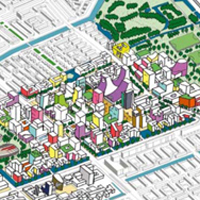Transit Oriented Development: a Solution for Station Areas Planning
Abstract
The need of reducing urban sprawl, the increasing number of motorized trips, the presence brownfields in strategic areas of cities, great investments in rail transport infrastructures, are all key elements that contribute to the diffusion of “Transit Oriented Development” theories and practices. In many cases applications of TOD principles are still complex, even though is widely recognized in theory the necessity of densify station areas with high quality and functional mix developments. Starting from this critical point, the main research question of this work is: how is it possible to “export” TOD principles and practices in Europe? The article try to answer this question through a comparative analysis of different best practice in Europe and through the definition of TOD procedures. The study analyses the TDA (Transport Development Area) approach proposed by the RICS in UK and the Stedebaan project in The Netherlands. Furthermore the research focuses on the France and Germany study cases, where the regional rail-oriented development is mainly connected with the HST lines construction and the rail network “regionalization” process. Also in Italy the important investment in rail infrastructures was the occasion for station area renewal and station area revitalising, but in most cases with an “urban design” approach rather than transport-land use integrated approach. The main conclusion stress the necessity of a new integrated approach and the definition of a “Station Plan” for the integration of urban and transport interventions.Downloads
References
Arrington G.B., Parker T. (2001) Factors for Success in California’s Transit-Oriented Development. Sacramento: California Department of Transportation, Statewide Transit-Oriented Development Study.
Atelier Zuidvleugel (2007) Space and line, Nova Terra Connected Cities, pp.11-16
Bertolini L. (2008) Station areas as nodes and places in urban networks: An analytical tool and alternative development strategies, in Bruinsma et al. (eds.) Railway Development: Impacts on Urban Dynamics, Physica-Verlag a Springer Company
Calthorpe P. (1993) The Next American Metropolis: Ecology, Community, and the
American Dream. Princeton: Princeton Architectural Press. Cervero R., Duncan M. (2002) Transit’s Value Added. Urban Land, Vol. 61, No. 2., pp. 77-84.
Cervero R. Ferrell C. Murphy C. (2002) Transit-Oriented Development and Joint Development in the United States: A Literature Review, TCRP Project H-27, Research Results Digest October 2002—Number 52.
Dupuy G. (1999) La dépendence automobile: symptômes, analyses, diagnostic, traitemets, Anthropos, Paris
Hine P. et al. (2005) Transport Development Areas, in Nova Terra Connected Cities, pp.8-11.
Huang H. (1996) The Land-use Impacts of Urban Rail Transit Systems. Journal of Planning Literature, Vol. 11, No. 1, pp. 17-30.
Newmann P.W.G., Kenworthy J.R. (1999) Sustainability and cities: overcoming automobile dependence, Washington D.C., Island Press.
OIKOS Centro Studi (2003) Trasporti e Qualità urbana. Il rinnovo delle stazioni come occasione di riqualificazione urbana, Regione Emilia Romagna.
Project Bahn.Ville (2005) Project Bahn.Ville: développement urbain orienté vers le rail et intermodalité dans le région urbaines allemandes et françaises, Imprimerie GIROLD, Gresswiller.
Royal Institution of Chartered Surveyors (2002) Transport Development Areas - Guide to Good Practice, London.

Copyright (c) 2014 Tema. Journal of Land Use, Mobility and Environment

This work is licensed under a Creative Commons Attribution 4.0 International License.
Authors who publish in this journal agree to the following:
1. Authors retain the rights to their work and give in to the journal the right of first publication of the work simultaneously licensed under a Creative Commons License - Attribution that allows others to share the work indicating the authorship and the initial publication in this journal.
2. Authors can adhere to other agreements of non-exclusive license for the distribution of the published version of the work (ex. To deposit it in an institutional repository or to publish it in a monography), provided to indicate that the document was first published in this journal.
3. Authors can distribute their work online (ex. In institutional repositories or in their website) prior to and during the submission process, as it can lead to productive exchanges and it can increase the quotations of the published work (See The Effect of Open Access)
